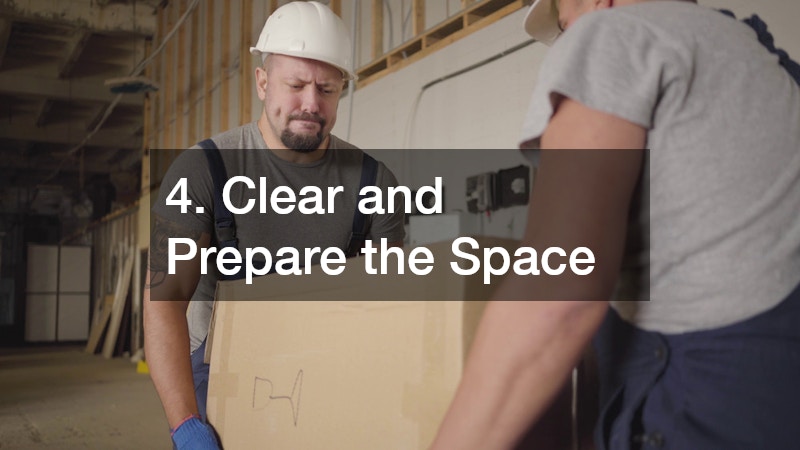A basement remodel can transform one of the most overlooked areas of your home into a functional, beautiful, and valuable space. Whether you dream of a cozy entertainment room, a guest suite, a home gym, or a quiet office, a well-planned remodel can make your vision a reality. The process, however, requires careful preparation and the right team of professionals to ensure the finished space is safe, comfortable, and long-lasting. From evaluating your existing foundation and utilities to choosing finishes that withstand the unique environment of a basement, each step plays an essential role in achieving a durable result.
Before starting your project, it’s vital to work with basement remodeling experts who understand the unique challenges that below-ground spaces present. Basements can have moisture issues, limited natural light, and ventilation concerns that require precise planning. This guide will help you think through every step—from the initial inspection to the final coat of paint—so you can move forward confidently. By following this comprehensive checklist, homeowners can avoid common pitfalls, save time, and create a basement that enhances both daily living and property value.
1. Evaluate Your Basement’s Current Condition

Before diving into design ideas or material choices, take time to evaluate your basement’s existing condition. Start by inspecting for moisture, cracks, or uneven flooring that could indicate foundation or drainage problems. Look for signs of water damage along walls or floors, as these could compromise future finishes if not addressed early. A professional assessment by basement remodeling experts can reveal hidden structural or plumbing issues that may need attention before any remodeling begins. It’s also important to check ventilation, ceiling height, and the overall structural soundness of the area to determine if it meets your goals.
For a more technical review, consider bringing in licensed professionals. A structural inspector can ensure the foundation is stable, while a local plumber can check drainage and water lines for leaks. If electrical wiring or breaker panels are located in the basement, have an electrician confirm everything is up to code. Addressing these details in advance helps avoid major headaches later. A careful inspection sets the foundation—literally and figuratively—for the rest of your project and ensures your remodeling investment will stand the test of time.
2. Set a Clear Vision and Design Plan
Once you know the state of your basement, the next step is to define your vision. Ask yourself how you want to use the space: Will it become an entertainment zone, a family room, a home office, or a full guest suite? Identifying the purpose guides your design decisions, layout, and budget. Take note of the natural light available and whether you’ll need additional lighting or egress windows. Basement remodeling experts often suggest creating separate zones for different uses, such as a living area, a wet bar, and storage. Your design plan should balance functionality with comfort and visual appeal.
After developing a concept, reach out to a reputable home remodeler who can refine your ideas into workable plans. Professionals can create layouts that optimize your square footage while ensuring compliance with local building codes. They’ll also help you anticipate needs like ventilation systems, soundproofing, and insulation. This planning phase is where creativity meets practicality, and every decision—from door placement to ceiling height—affects the outcome. Investing time and effort in a detailed design will help prevent expensive changes once construction starts.
3. Establish a Realistic Budget
Budgeting is one of the most critical parts of any remodel. Start by listing all potential expenses, including labor, materials, permits, and finishing touches. Consult basement remodeling experts early to get a realistic sense of costs in your area. Pricing can vary based on square footage, existing conditions, and your desired level of finish. Be sure to build flexibility into your budget by setting aside at least 10–15% for unexpected issues like hidden water damage or electrical upgrades. Knowing your financial limits ahead of time will make it easier to prioritize what’s most important.
When getting quotes, request detailed breakdowns from each contractor. A reliable home remodeling company can provide a transparent estimate that outlines labor and material costs separately. Ask questions about payment schedules and what happens if the project runs over time or budget. Including multiple estimates will help you compare apples to apples and spot unrealistic bids. Don’t forget smaller costs such as design consultations, permits, or debris disposal. With a clear budget and contingency plan, you’ll be better equipped to make confident decisions throughout the remodeling process.
4. Clear and Prepare the Space

Before construction can begin, your basement must be cleared of clutter, furniture, and old finishes. This step may seem minor, but it’s crucial for efficiency and safety. Moving large items out of the basement not only provides a clean workspace but also protects your belongings from dust and damage. Homeowners often underestimate the effort needed for this stage, especially if the basement has been used for long-term storage. Basement remodeling experts recommend setting aside time to sort through old items, discard what’s no longer needed, and properly organize what remains.
If you have bulky furniture or heavy boxes, hiring a moving service can save time and prevent injuries. Once cleared, inspect the walls and floor for any lingering moisture or damage that may have gone unnoticed. Now is also the time to remove outdated paneling, drop ceilings, or damaged flooring so the area is ready for construction. Clearing the basement thoroughly ensures your contractors can work efficiently and identify any potential problems early. Preparing properly may feel tedious, but it’s one of the smartest steps toward a smooth and successful remodel.
5. Focus on Waterproofing, Plumbing, and Electrical Systems
Waterproofing is essential to protect your investment. Even a small leak can ruin new drywall, flooring, and furniture. Start by addressing any drainage or foundation issues that may cause water intrusion. Adding sump pumps, drain tiles, and vapor barriers can help keep the space dry. This is also the stage to involve a local plumber who can inspect and adjust pipes, install new lines for bathrooms or laundry, and ensure proper water flow. Basement remodeling experts stress that tackling plumbing and waterproofing early prevents future mold and costly repairs.
Equally important is updating electrical systems. Hire a licensed electrician to ensure all wiring, outlets, and lighting meet safety codes. Basements often need extra circuits for new appliances, entertainment setups, or home offices. Having your electrical and plumbing systems updated before insulation and drywall installation makes it easier to access and fix any issues. Finally, test all systems before closing walls to ensure everything functions perfectly. Solid infrastructure is the backbone of any successful basement remodel.
6. Build a Strong Structure with Framing and Insulation
Once your utilities are in place, it’s time to frame walls and define your new rooms. Proper framing creates the structure for your finished design and helps control the flow of the space. Ensure framing materials are moisture-resistant and installed correctly to avoid warping or mildew. Professional basement remodeling experts can design walls to support built-in shelves, entertainment centers, or partitions for separate rooms. This stage also includes soundproofing, which can make the basement feel quieter and more private.
Next comes insulation, which plays a key role in comfort and energy efficiency. Use foam board, spray foam, or mineral wool insulation, depending on your local climate and the basement’s humidity. Pay close attention to sealing around windows, vents, and electrical outlets to prevent air leaks. Proper insulation helps maintain consistent temperatures, reducing heating and cooling costs. A well-framed and insulated basement sets the stage for finishes that not only look beautiful but also perform well over time.
7. Choose Durable and Stylish Finishes

Selecting the right materials for your basement is about balancing aesthetics and practicality. Basements are prone to temperature changes and humidity, so finishes must withstand these conditions. Flooring is one of the most critical choices—avoid carpet in areas that could get damp. Work with a reputable flooring company to explore water-resistant materials like vinyl plank, tile, or engineered wood. Basement remodeling experts often recommend lighter colors to brighten the space and create the illusion of openness. Durable finishes make maintenance easier and extend the lifespan of your investment.
For walls, moisture-resistant drywall or paneling is ideal. Once installed, consider textures and finishes that complement the rest of your home. Lighting also plays a huge role in how your basement feels—combine recessed lights, sconces, and task lighting for versatility. You can even incorporate ceiling designs that hide ductwork elegantly. Investing in quality finishes ensures your basement not only looks inviting but also functions well for years to come.
8. Add Color and Personality to the Space
After your walls and ceilings are ready, it’s time to bring your basement to life with color. Visiting a paint store can be an inspiring experience as you explore hues that suit your desired atmosphere. Neutrals create a timeless, elegant look, while soft blues and greens add tranquility. Before painting, ensure the walls are properly primed and sealed to prevent moisture-related peeling. Basement remodeling experts often recommend satin or semi-gloss finishes because they’re easy to clean and reflect light beautifully, brightening darker areas.
For the best results, consider hiring painting companies that specialize in interior finishes. Professionals can achieve smooth coverage and crisp lines that are difficult to replicate on your own. They also know which paints perform best in below-grade environments. Accent walls, trim, and subtle contrast can give your basement personality and character. Thoughtful color choices create cohesion and warmth, transforming what might have once been a dark storage area into a welcoming extension of your home.
9. Incorporate Functionality and Custom Features
Now comes the fun part—adding custom details that make your basement uniquely yours. Built-ins and custom cabinets can optimize space while adding sophistication and storage. Whether you need shelving for a home office or cabinetry for a mini bar, these features make the basement both beautiful and functional. Basement remodeling experts can help design cabinetry tailored to your layout and lifestyle. Thoughtful design choices here can turn a basic remodel into a personalized retreat that reflects your taste.
Beyond storage, consider creating multi-purpose areas such as a playroom that converts into a guest suite. If space allows, adding a small bath remodel can make your basement more convenient for guests or renters. Proper plumbing, ventilation, and waterproofing are essential, so work with licensed professionals for installation. Smart home additions—like integrated speakers, lighting controls, or energy-efficient thermostats—can make your new basement both high-tech and comfortable.
10. Final Touches, Cleanup, and Move-In Preparation

As your project nears completion, focus on the finishing details that make the space feel truly complete. This includes final inspections, cleanup, and preparing for move-in. Ensure your contractor reviews all systems—plumbing, electrical, HVAC, and finishes—to verify everything functions as intended. This step ensures your warranty remains valid and that you’re satisfied with the workmanship. Basement remodeling experts emphasize the importance of documenting the final walkthrough with photos and keeping receipts for future maintenance or resale value.
Once inspections are complete, it’s time to furnish and decorate. Use a moving service to safely transport furniture back into the basement without damaging new walls or floors. Add rugs, lighting fixtures, and décor that align with your design theme. Don’t forget small details such as baseboards, light switch covers, or hardware finishes. When all is said and done, step back and enjoy your transformed space—a beautiful, functional extension of your home that reflects careful planning and collaboration.
A basement remodel is an exciting opportunity to expand your living space, increase property value, and enhance your home’s overall comfort. By following a detailed checklist and partnering with the right professionals, homeowners can navigate every stage—from evaluation to finishing touches—with confidence. The key lies in preparation: addressing foundational issues, setting realistic budgets, and working with experienced basement remodeling experts who understand the nuances of below-ground construction.
Whether you’re consulting a home remodeling company, collaborating with an electrician, or choosing finishes from a paint store, each decision adds to the quality of your final space. Thoughtful planning, durable materials, and expert craftsmanship will transform your basement into an inviting and functional extension of your home. With patience and precision, your once-forgotten basement can become one of the most rewarding areas of your property—proof that the best transformations start from the ground up.

